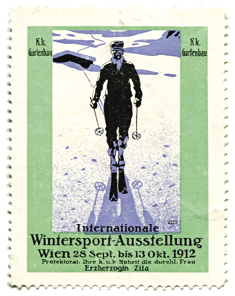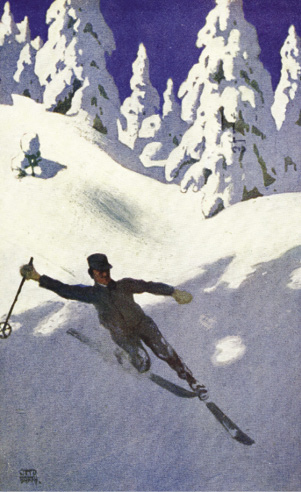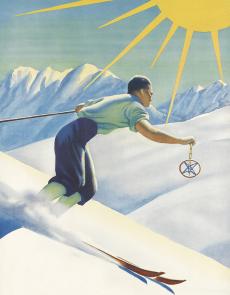SKIING HISTORY
Editor Seth Masia
Managing Editor Greg Ditrinco
Consulting Editor Cindy Hirschfeld
Art Director Edna Baker
Editorial Board
Seth Masia, Chairman
John Allen, Andy Bigford, John Caldwell, Jeremy Davis, Kirby Gilbert, Paul Hooge, Jeff Leich, Bob Soden, Ingrid Wicken
Founding Editors
Morten Lund, Glenn Parkinson
To preserve skiing history and to increase awareness of the sport’s heritage
ISHA Founder
Mason Beekley, 1927–2001
ISHA Board of Directors
Rick Moulton, Chairman
Seth Masia, President
Wini Jones, Vice President
Jeff Blumenfeld, Vice President
John McMurtry, Vice President
Bob Soden (Canada), Treasurer
Einar Sunde, Secretary
Richard Allen, Skip Beitzel, Michael Calderone, Dick Cutler, Ken Hugessen (Canada), David Ingemie, Joe Jay Jalbert, Henri Rivers, Charles Sanders, Christof Thöny (Austria), Ivan Wagner (Switzerland)
Presidential Circle
Christin Cooper, Billy Kidd, Jean-Claude Killy, Bode Miller, Doug Pfeiffer, Penny Pitou, Nancy Greene Raine
Executive Director
Janet White
janet@skiinghistory.org
Membership Services
Laurie Glover
(802) 375-1105
laurie@skiinghistory.org
Corporate Sponsorships
Peter Kirkpatrick
(541) 944-3095
peterk10950@gmail.com
Bimonthly journal and official publication of the International Skiing History Association (ISHA)
Partners: U.S. Ski and Snowboard Hall of Fame | Canadian Ski Museum and Hall of Fame
Alf Engen Ski Museum | North American Snowsports Journalists Association | Swiss Academic Ski Club
Skiing History (USPS No. 16-201, ISSN: 23293659) is published bimonthly by the International Skiing History Association, P.O. Box 1064, Manchester Center, VT 05255.
Periodicals postage paid at Manchester Center, VT and at additional mailing offices. Postmaster: Send address changes to ISHA, P.O. Box 1064, Manchester Center, VT 05255
ISHA is a 501(c)(3) public charity. EIN: 06-1347398
Written permission from the editor is required to reproduce, in any manner, the contents of Skiing History, either in full or in part.
Ski Art: Otto Barth (1876-1916)
Otto Barth was a sickly child. To gain strength, he was taken to the mountains at age 16. The same year, he was admitted to the Viennese Academy of Fine Arts. Two years later, he teamed up with his artist friend Gustav Jahn for serious mountaineering. He died, probably of lead poisoning from his paints, at age 39.
Turn-of-the-century Vienna rivalled Paris with artistic experimentation. Barth socialized with a group of artists who rebelled against the progressive Secession movement to form the more radical Hagenbund. Going further still, he joined the short-lived Phalanx, which exhibited post-Impressionist and Jugendstil (art nouveau) paintings.
In 1910 Barth won the commission for the poster of the Salzkammergut resort region. The telemarking skier is shown in fine form, and in the correct Norwegian blue outfit. What’s striking is the use of color and shadow, as well as the depiction of snow itself.

The other illustration is the poster turned Werbemarke (advertising stamp) for the Wintersport-Ausstellung, the Winter Sport Exhibition of 1912. The image of a skier descending from the mountains is center stage, again using those hints of shadow. This was an important exhibition, organized by army officer Hermann Czant (Czant was an acolyte of Matthias Zdarsky and trained thousands of Imperial Army skiers), under the patronage of the Grandduchess Zita, who would become the last empress of the Austro-Hungarian Empire.
The exhibition was divided between the business of winter sports and the physical aspects of the sport itself. The top Vienna sporting goods shop, Mizzi Langer, was represented, as was Staub of Innsbruck. Norway sent representatives, and Norwegian ski outfits and British winter sports clothes dominated. One critic was thankful there were no new bindings (controversy then raged over binding design for Alpine skiing). On the resort side, Semmering showed a model of its ski jump, and there were other displays from Triberg, the Schwarzwald, the Arlberg and Innsbruck. The trail marking from the Erzgeberge was singled out positively.
There was also a good collection of winter posters and some paintings, too. The best of those were by Jahn and Barth. I like to think that the telemarking skier was one on view; it was painted before the year of the exhibition.
Table of Contents
WORLD CHAMPIONSHIP ($3,000+)
BerkshireEast/Catamount Mountain Resorts
Gorsuch
Warren and Laurie Miller
Sport Obermeyer
Polartec
CHAMPIONSHIP ($2,000)
Fairbank Group: Bromley, Cranmore, Jiminy Peak
Hickory & Tweed
Rossignol
Snowsports Merchandising Corporation
WORLD CUP ($1,000)
Aspen Skiing Company
Bogner of America
Boyne Mountain Resort
Dale of Norway
Darn Tough Vermont
Dynastar/Lange/Look
Gordini USA Inc/Kombi LTD
Head Wintersports
Intuition Sports
Mammoth Mountain
Marker/Völkl USA
National Ski Areas Association
Outdoor Retailer
Ski Area Management
Ski Country Sports
Sports Specialists Ltd
Sun Valley Resort
Vintage Ski World
World Cup Supply
GOLD MEDAL ($700)
Larson's Ski & Sports
Race Place/Beast Tuning Tools
The Ski Company (Rochester NY)
Thule
SILVER MEDAL ($500)
Alta Ski Area
Boden Architecture PLLC
Dalbello Sports
Deer Valley
EcoSign Mountain Resort Planners
Elan
Fera International
Holiday Valley Resort
Hotronic USA/Wintersteiger
Masterfit Enterprises
McWhorter Driscoll LLC
Metropolitan New York Ski Council
Mt. Bachelor
New Jersey Ski & Snowboard Council
Russell Mace Vacation Homes
SchoellerTextil
Scott Sports
Seirus Innovations
SeniorsSkiing.com
Ski Utah
Steamboat Ski & Resort Corp
Sundance Mountain Resort
Swiss Academic Ski Club
Tecnica Group USA
Timberline Lodge and Ski Area
Trapp Family Lodge
Western Winter Sports Reps Association
World Pro Ski Tour
Yellowstone Club


